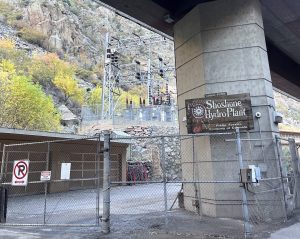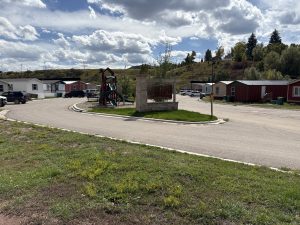Mountain Rail project steams ahead: 2026 launch on track after Moffat Tunnel, Union Pacific deal

Byron Hetzler/Sky-Hi Daily News
The Colorado Department of Transportation’s Mountain Rail project team offered the public a detailed update at their June 18 open house, highlighting recent milestones, ridership successes and next steps as the state moves closer to launching passenger rail service between the Front Range and the Yampa Valley.
The event, held in Fraser, offered the most detailed look yet at the phased service plan, funding realities and the collaborative spirit driving the effort.
The most significant update shared by Mo Sullivan, assistant director of passenger rail for CDOT, was the May 1 agreement between the state and Union Pacific to extend the Moffat Tunnel lease for 25 years.
This deal, Sullivan emphasized, is “the starting line for Mountain Rail,” unlocking the tunnel for up to three daily round trips of passenger service — on top of existing Amtrak offerings — and up to 500,000 train miles annually dedicated to passenger rail.
Union Pacific, for its part, retains its freight operations while agreeing to a detailed passenger-use agreement. According to Sullivan, the agreement outlines construction responsibilities, operational milestones and performance metrics — all crucial for ensuring the reliability of passenger service, a frequent concern among residents and stakeholders.
The expanded Winter Park Express service last season provided a real-world test case for the Mountain Rail concept. By starting service in December, adding more days (including Thursdays and Mondays) and increasing train capacity, ridership soared by 153% over the previous year, said Sullivan.
Notably, ticket prices for the expanded Winter Park service were kept low thanks to funds from Colorado State Senate Bill 24-184, which created a congestion mitigation fee, said Sullivan, making the service accessible to more Coloradans and families. The season also boasted zero canceled runs and strong on-time performance, key indicators that reliable, affordable rail can draw considerable demand.
Sullivan explained that the Mountain Rail project plan is built around three service patterns, each designed to serve distinct travel needs:
- Short pattern: Scheduled to launch in November 2026, the short pattern, or Phase 1, will offer one daily round trip between Denver Union Station and Granby, leveraging existing stations and requiring only minimal new infrastructure, such as a layover facility in Granby and storage tracks in Denver. A second round trip, with a “mirror” schedule starting in Granby, is planned as soon as capacity improvements are completed.
- Long pattern: This would extend service all the way to Craig, providing a scenic journey through the Western Slope. While not expected to compete with car travel times, it aims to attract tourists and those seeking a unique Colorado experience. Significant infrastructure upgrades, however, including signaling and track improvements, are required before this phase can launch.
- Local Yampa Valley service: Envisioned as a commuter option for residents and workers in the valley, this service would offer an alternative to driving U.S. Highway 40, addressing both housing and congestion challenges. Like the long pattern, the commuter path is dependent on substantial new infrastructure and close partnership with local municipalities.
A specific start date has not yet been set for the long pattern or the commuter path.
Throughout 10 open houses, CDOT and its consultants have fielded extensive feedback from residents, elected officials and business leaders. Station locations remain a top concern, with each municipality’s unique needs — multimodal connections, parking, amenities and accessibility — factoring into the design.
Sullivan stressed that “the station you get in your community should reflect your community,” and that local governments will play a key role in shaping and, in later phases, potentially funding new stations.
The June open house also highlighted the cooperative tone of the project.
Representatives from Steamboat Springs and Routt County, including Councilor Michael Buccino and Commissioner Sonja Macys, as well as officials from Winter Park, Grand County and the Colorado Transportation Commission were present, underscoring the broad coalition behind Mountain Rail. Sullivan said that consultant teams working on the project are “overwhelmed with the positivity, enthusiasm and engagement” from the corridor’s communities.
Mountain Rail’s immediate funding comes from the state’s congestion mitigation fee — $3 per rental car, adjusted for inflation, expected to generate $57 million in 2026 and up to $110 million by 2050. At least 40% of these funds are currently earmarked for passenger rail and related projects.
The revenue from the fee, however, is not a blank check: it must also support other congestion mitigation efforts statewide, and future phases may require additional revenue streams, including farebox recovery and, potentially, local or federal contributions.
Sullivan acknowledged concerns from an audience member about the sustainability of relying on rental car fees. While local tax increases are not currently planned, she emphasized the importance of keeping service affordable and maximizing ridership to ensure long-term viability.
Audience questions at the open house reflected both excitement and pragmatic concerns.
Ranchers along the corridor urged thorough safety inspections and easement improvements. Others pressed for assurances regarding on-time performance, citing Amtrak’s struggles competing with freight railroads.
Sullivan pointed to the new passenger-use agreement with Union Pacific, which includes performance incentives and metrics to protect passenger service reliability.
Rolling stock procurement, regulatory approvals from the Federal Railroad Administration and finalizing operator agreements are immediate next steps, said Sullivan. Used rolling stock will be deployed initially to meet the aggressive 2026 timeline, with new Colorado-specific trains planned for later phases.
With the Moffat Tunnel deal secured, funding in place for the first phase and a clear-eyed approach to challenges ahead, Colorado is poised to deliver its most ambitious passenger rail project in decades.
“All aboard the train … that first phase implemented in November of 2026 is our North Star, and what we’re chugging ahead towards,” said Sullivan.

Support Local Journalism

Support Local Journalism
Readers around Steamboat and Routt County make the Steamboat Pilot & Today’s work possible. Your financial contribution supports our efforts to deliver quality, locally relevant journalism.
Now more than ever, your support is critical to help us keep our community informed about the evolving coronavirus pandemic and the impact it is having locally. Every contribution, however large or small, will make a difference.
Each donation will be used exclusively for the development and creation of increased news coverage.










